Thermaltake Armor A30 Case Review: Opening the Puzzle Box
by Dustin Sklavos on September 24, 2012 12:01 AM EST- Posted in
- Cases/Cooling/PSUs
- Thermaltake
- MicroATX
Noise and Thermal Testing, Dedicated GPUs
While the Zotac GeForce GTS 450 I typically add to smaller cases for testing tends to not cause too much of a racket or an increase in thermals, the GTX 560 Ti I've taken to using to test the more ambitious designs can create a very notable change. Given the pleasant surprise of the Thermaltake Armor A30's thermals and acoustics, I was curious to see if it would hold up under the increased stress. It did.
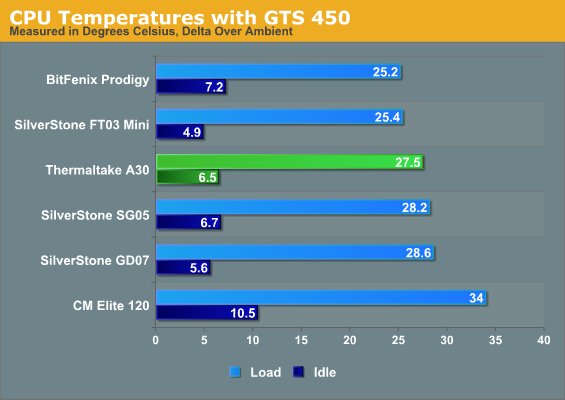
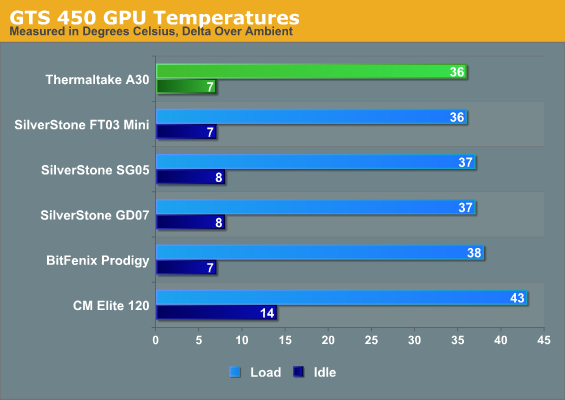
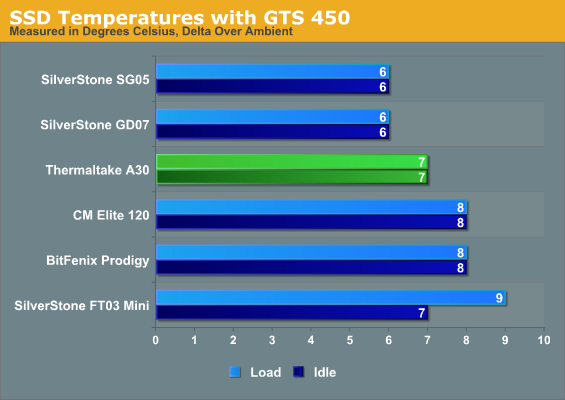
Once again, thermals in the A30 were competitive with the best of the smaller cases we've tested. It's clear the GTS 450 isn't adding a tremendous amount of stress to the situation.
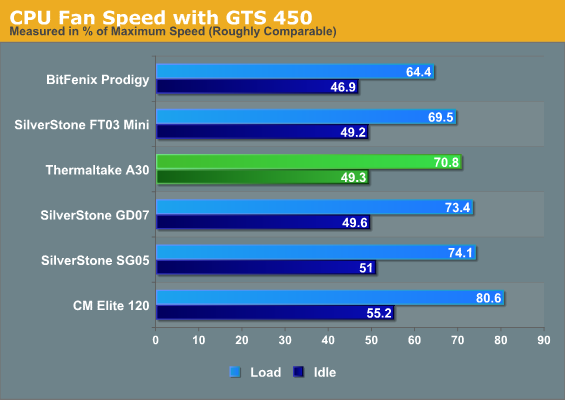
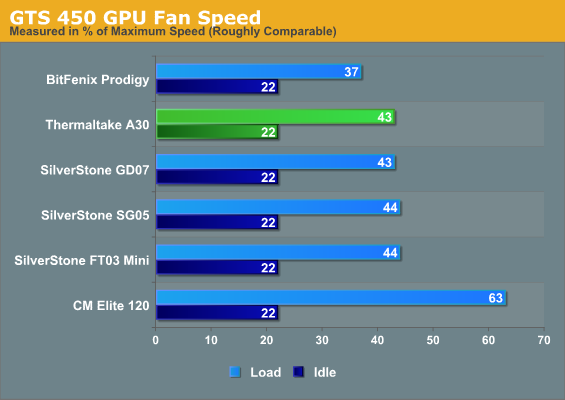
That sentiment is echoed when we look at the fan speeds; only the Prodigy and its...err...prodigious intake fan is able to best the rest of the pack.
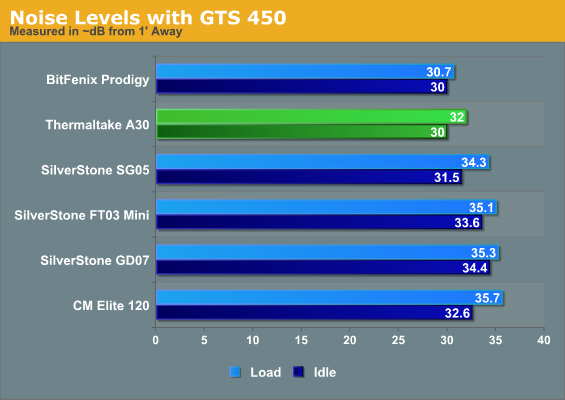
Under load the A30 is the second quietest behind the Prodigy; Thermaltake continues to impress. It's obvious an i3 and a single-slot, low-power GTS 450 aren't enough to really push this case, so let's see what happens when we install the much beefier GeForce GTX 560 Ti.
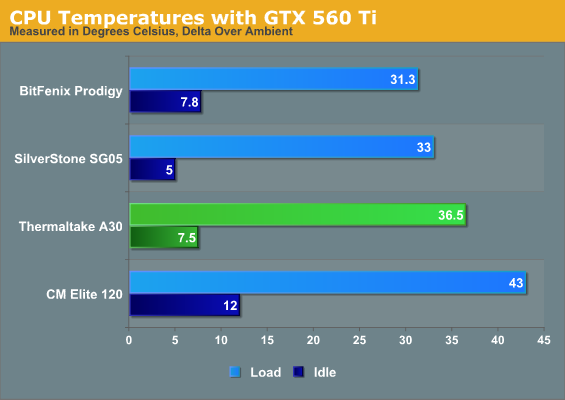
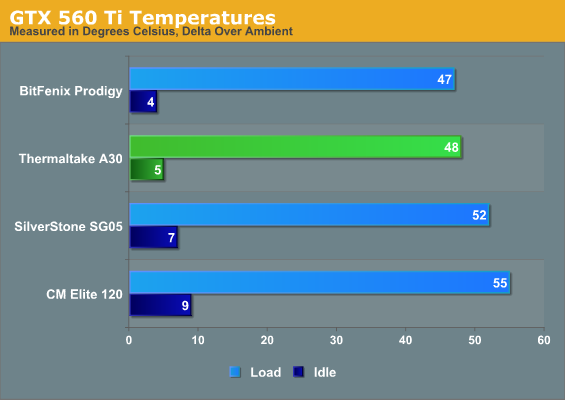
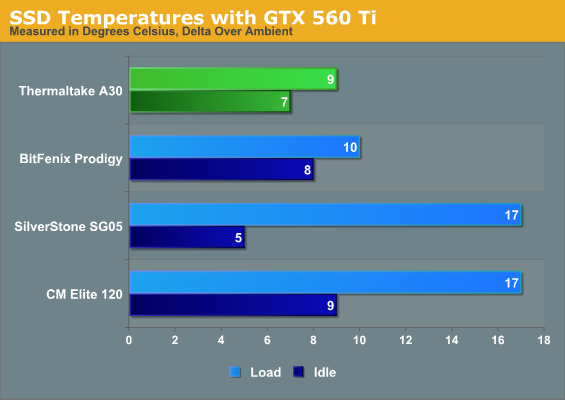
Things begin to separate but again, the A30's performance isn't bad at all. The SSD continues to experience very little heat due to its distance away from the heat-generating components; it doesn't get much airflow, if any, but doesn't need it as so little heat is really being trapped where it is.
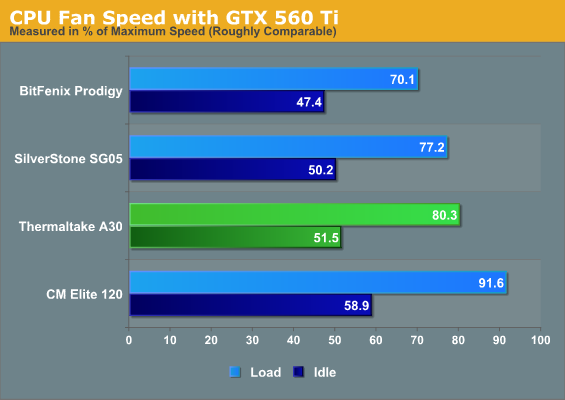
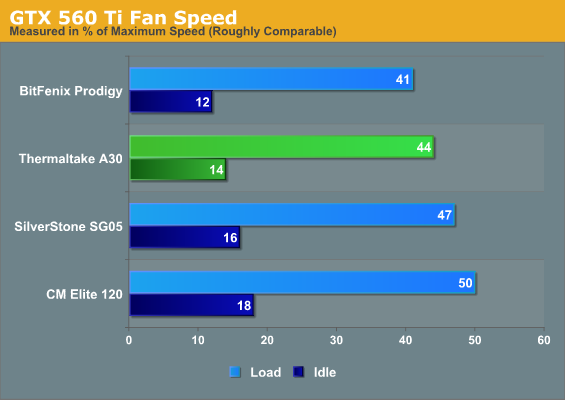
The A30's cooling design continues to be a pretty big winner. While the GTX 560 Ti isn't getting too much active airflow from the case itself, it has access to enough open space between it and the wall of the case (plus the ventilation near the top) to perform reasonably well.
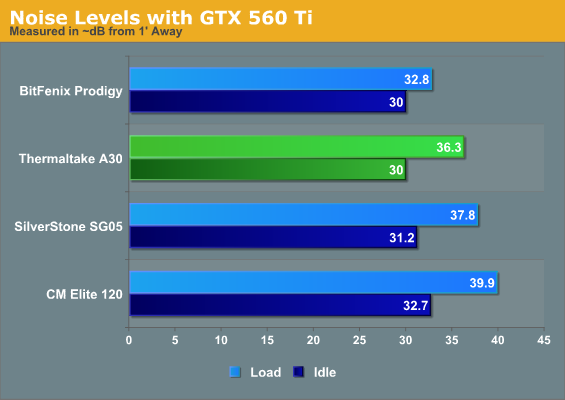
In my opinion, this is the A30's big victory. Acoustically it's still reasonably quiet, and though it can't compete with the Prodigy's size and thermal design, it's plenty competitive with the other cases we've tested. That said, it's important to keep in mind that it's also substantially bigger than the SilverStone SG05 (though I'd argue it doesn't make as efficient use of its space as SilverStone's design does).










26 Comments
View All Comments
Dadofamunky - Monday, September 24, 2012 - link
I tried a couple of microATX build with cases to match and finally gave up. It's always been too complicated and too high-maintenance for long-term use. In my experience with SFF (which ended some three years ago) the motherboards also tend to require too many compromises, including indifferently updated BIOSes, limited overclocking options compared to normal ATX boards and fewer SATA and USB ports. For me, though, the biggest headache always proved to be working with the cases and the hardware.Icehawk - Monday, September 24, 2012 - link
Maybe a few years ago? I built a mATX machine for the first time last month with an i7 and GTX670 using the (much larger but clearly MUCH nicer) Fractal Design Mini Define and while the mobo doesn't have a ton of options as you said, it has enough to run a simple O/C and XMP which is all I need.Zap - Monday, September 24, 2012 - link
You're doing it wrong. :P Well, it is easier these days too.First thing is to choose the right motherboard. They are available, and have as many SATA/USB ports as full ATX boards and can overclock as well as an ATX board of similar price point.
Second thing is to use a micro ATX mini tower, and NOT a "cube" style case. The computer still ends up a lot smaller than an ATX tower, and are just as easy to build.
Fuzz1111 - Monday, September 24, 2012 - link
While I'm interested cases of this style, I can't say I would recommend the sff cases that require the use of half-height cards, or any that don't allow alternative power supplies.Until recently my media centre was a build that used an Antec Minuet 350, an intel E2200 and cheap gigabyte board (had an intel chipset though). The board and cpu were fine, and with a zalman 8700 I even got a decent overclock. Unfortunately half-height turned out to be more limiting than I'd have thought - vidcard choices were rubbish (still aren't great), and I had to make my own half-height bracket for my TV tuner.
The worst problem by far was the power supply - it was a complete piece of crap and it got worse over time (in the end I was running without tuner card, and with DVD drive disconnected).
Death666Angel - Monday, September 24, 2012 - link
Can't say that I agree. Unless one specifically needs more than 2 GPUs, mATX is plenty enough. I've had my Gigabyte mATX P55 mainboard with an overclocked i7 860 since a month after the i7 came about (roughly). At first I had it in a cube case from Lian Li (V351B) with an HD5770. I had an optical drive, a 3.5" drive and a 2.5" SSD for my system in there. Had I wanted, I could have fitted more drives, the mainboard certainly provided all I needed. While it was a bit hard to assemble and maintain, it was pretty small, light, powerful and quiet. It also did not cost any more than a regular ATX with similar quality components. Last Christmas I decided to get the Silverstone TJ08-E because I wanted to get water cooling. That is also a mATX enclosure, much smaller than most ATX ones of that performance. The CPU now runs at 3.8GHz (up from 3.3 in the cube), my mainboard is still fully functional and has all the connections and abilities one can expect from a ~130€ board of the time.Unless you are doing LN2 OC'ing, it is stimply not true that ATX offers greater performance than mATX. Most often, they don't even offer more ports or better quality.
just4U - Monday, September 24, 2012 - link
I have to agree with other's on this.. Nothing wrong with Matx setups.. and you don't have real compromises with the MB either. Look at Asus's Gene line, Or Gigabytes M3.NA1NSXR - Friday, September 28, 2012 - link
My X58M was offered new BIOSes periodically to support the entire lifespan of 1366. It was also capable of overclocking as well as any full ATX board in its price range, well encompassing any OC on air cooling anyone would be doing. Fewer SATA ports are moot, as my mobo had way more ports than pretty much any matx enclosure could support anyway, and I had 8 USB ports. So I don't know what you are talking about. It sounds like you just did not do the planning, which is the funnest part anyway. There is no reason to use full atx on air cooled, single GPU computers anymore, unless the extra PCIe slots are absolutely needed.Quite frankly when I see a massive "gamer tower" these days I just roll my eyes.
Operandi - Monday, September 24, 2012 - link
Looks like a fairly decent case aside from the 60mm fans but holy crap does it eve stop with the taken to “11” overly designed boxes that constantly try to convey the image of just about anything but a PC case?That and the price is a joke when I can get a Lian LI PC-Q08B for the same price.
Lucian2244 - Monday, September 24, 2012 - link
I second that, it looks like a travel bag !And if it was hard for you to assemble it, i can't imagine how it would be for me as I only assembled ATX cases so far.
Mr Perfect - Monday, September 24, 2012 - link
Yeah, that's way to busy for a SFF case. Angles here, windows there, extra vents, raised lines, additional bevels and a pop-up roof. To be fair, it looks like they took a full ATX design(that probably looked fine) and scaled it down until everything got jammed together.